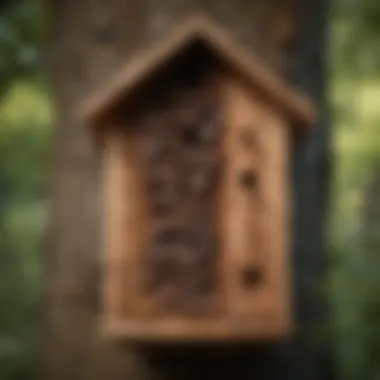Optimal Timing for Bat House Installation


Intro
The installation of bat houses is an essential aspect of supporting bat populations, which play a vital role in maintaining ecological balance. Understanding the optimal timing for such installations is crucial for maximizing their effectiveness. This article aims to provide a well-rounded perspective on when to undertake this task, offering insights from various disciplines that intersect with bat conservation and woodland ecosystems. By considering ecological factors, seasonal behaviors, and practical approaches to promoting biodiversity, woodland enthusiasts and environmental stewards can make informed decisions to enhance their local ecosystems.
Understanding Woodland Ecosystems
Importance of Biodiversity in Forests
Biodiversity within forests is fundamental for sustaining healthy ecosystems. High species variety promotes resilience, enabling ecosystems to withstand environmental changes and disturbances. Bats contribute significantly to this diversity, acting as natural pest controllers. Their foraging habits reduce the need for chemical pesticides, benefiting both human populations and the environment. Thus, installing bat houses at appropriate times not only supports bat populations but also aids in preserving the overall health of woodland ecosystems.
Role of Forests in Climate Regulation
Forests serve as critical carbon sinks, absorbing carbon dioxide and helping to regulate global temperatures. The intricate interplay between forestry and climate regulation is paramount. Emphasizing the need for effective bat populations, which assist in controlling insect populations, can result in healthier, more balanced forests that contribute positively to climate stability. Understanding this relationship underscores the importance of strategically timing bat house installations to align with ecological cycles.
Sustainable Forestry Practices
Principles of Sustainable Forestry
Sustainable forestry practices encompass methods that maintain the health of forest ecosystems while providing for the needs of present and future generations. Incorporating bat houses into these practices enhances the sustainability of the forest by promoting biodiversity. Key principles include:
- Maintaining a balanced ecosystem
- Protecting wildlife habitats
- Implementing responsible resource management
Case Studies of Successful Implementations
Exploring case studies reveals successes in integrating bat conservation into forestry practices. For instance, certain parks and conservation areas have successfully installed bat houses during late winter, ensuring readiness for spring when bats emerge from hibernation. Observing these instances provides valuable lessons for others looking to support bat populations effectively.
Woodland Stewardship Techniques
Forest Management Plans
An effective forest management plan should consider bat house installation as a vital component. This plan should include timelines, location assessments, and monitoring strategies to evaluate the success of the installed bat houses. Addressing these elements ensures that forestry practices remain beneficial to wildlife and the surrounding environment.
Conservation Strategies
Conservation strategies focusing on bats involve understanding their habitat preferences and seasonal movements. Installing bat houses in the early spring - when bats are returning from hibernation and seeking roosting sites - can enhance the likelihood of them occupying the houses. This informed approach not only aids in biodiversity but also strengthens woodland stewardship efforts overall.
Supporting bat populations through strategic actions, such as the proper timing of bat house installations, fosters healthier woodland ecosystems and contributes to global biodiversity.
By understanding the dynamics of bat conservation and its intertwining with forestry and biodiversity, professionals in the field can make impactful decisions that benefit both bats and the woodland environments they inhabit.
Preface
The installation of bat houses is vital in promoting bat conservation and safeguarding biodiversity. Increased urbanization and habitat loss have made these measures necessary. By providing artificial roosting sites, we can create a supportive environment for bats, which play essential roles in ecosystems. These small mammals are natural pest controllers, aiding in managing insect populations and contributing to pollination processes.
Importance of Bat Conservation
Bats are often misunderstood and face numerous threats, including habitat degradation and disease. Their population decline affects ecological balance and agricultural productivity. Protecting bats directly influences the health of our ecosystems. As effective predators of insects, bats help regulate pest populations that can ravage crops and transmit diseases. Conserving bats also promotes biodiversity, as these creatures are an integral part of the food web.
Overview of Bat Houses
Bat houses serve as artificial habitats for bats. They differ from birdhouses, designed specifically to meet the unique needs of bats. Effective bat houses provide adequate space, warmth, and protection from predators. Placement and design are crucial factors for successful occupancy. Various styles exist, ranging from single-chamber to multi-chamber houses. Each design targets specific bat species, addressing varying needs within their habitat preferences. Beyond mere installation, understanding bat behavior—such as roosting and feeding habits—greatly enhances the effectiveness of these structures.
In sum, tackling bat conservation requires a solid understanding of their ecology and behaviors. Selecting proper installation timing optimizes bat house effectiveness, significantly contributing to their preservation.
Understanding Bat Behavior
Understanding bat behavior is essential for optimizing the timing of bat house installation. Bat populations are influenced by their migration patterns, breeding cycles, and hibernation habits. By considering these factors, we can make informed decisions that improve the chances of attracting bats and supporting their conservation.


Migration Patterns
Bats are migratory animals. They travel to warmer climates during colder months. Most species return to their original locations for breeding when temperatures rise. Knowing the migration patterns helps determine when to install bat houses. Ideally, installation should occur before bats return in spring. This allows them to find shelter as they arrive.
Bats often migrate alone or in small groups. Some species, like the Brazilian free-tailed bat, journey hundreds of miles. Others, such as the little brown bat, may only move short distances. Understanding these patterns informs when and where to install bat houses effectively.
Breeding Cycles
Breeding cycles greatly affect bat behavior. Most bats breed once a year, typically in late spring or early summer. Female bats give birth to one or two pups after a gestation period of about two months. If bat houses are installed during this time, they provide safe spaces for mothers to raise their young.
Installing bat houses just before or during the breeding season is beneficial. It gives female bats time to discover these new roosting sites. Many bats prefer to roost in colonies, so a well-placed bat house can attract several families. Proper timing is vital for maximizing the success of the installation.
Hibernation Habits
Hibernation is another critical phase in bat behavior. Different species have different hibernation habits. Some hibernate in caves, while others find shelter in trees or buildings. Installing bat houses before winter allows them to find alternative shelter. This can be essential in areas with limited natural hibernacula.
It’s important to consider the specific hibernation habits of local bat species. Certain species will benefit from roosting sites that maintain stable temperatures. For example, the endangered Indiana bat prefers temperatures between 32-40 degrees Fahrenheit. Installing houses in suitable locations can support bats during this vulnerable time of year.
"Understanding bat behavior is crucial for effective conservation. Timing the installation of bat houses can significantly impact the local bat population."
Seasonal Considerations
The key elements to consider regarding seasonal influences include:
- Bat activity levels vary with temperature and food availability.
- Timing impacts the adjustment of bat houses to local ecology.
- Installation aligned with seasonal behaviors can increase bat occupancy rates.
By considering the seasonal elements, individuals can better support bat populations, increasing local biodiversity and ensuring healthier ecosystems.
Spring: A Season of Activity
Spring marks a time of renewal and increased activity for bats. As temperatures rise, bats awaken from their winter hibernation. This is the time when many species begin to search for suitable roosting sites. Installing bat houses in early spring can align perfectly with this period of heightened activity.
During spring, female bats often seek out locations to form maternal colonies. These colonies are critical for raising their young.
To enhance effectiveness:
- Choose elevated areas that receive sunlight during the day.
- Avoid spots directly adjacent to human activity, as bats prefer undisturbed locations.
Proper installation in this season can position the bat house for optimal usage immediately as bats emerge from hibernation.
Summer: Optimal Conditions
Summer is typically characterized by warm weather, making it an ideal time for bats to thrive. In this period, bats can be seen actively foraging for insects, which are abundant during these months. Bat houses installed in early to mid-summer can take advantage of high bat populations looking for roosting spots during the day.
Key considerations for summer installations include:
- Ensure that bat houses are shaded in the hottest part of the day.
- Provide easy access to nearby food sources, such as ponds or gardens thriving with insects.
Installing bat houses during this season is advantageous as it allows new bat families to settle in before late summer, which increases their chances of survival and reproduction.
Autumn: Pre-Hibernation Preparations
As autumn arrives, bats begin their preparations for hibernation. This transition period is crucial for their survival. Some species may start seeking places that will serve as roosts for the coming winter. By installing bat houses in the autumn, it provides an option for bats looking for suitable hibernation locations.
During this time:
- Opt for slightly warmer sites, as energy conservation is vital.
- Monitor local weather patterns since colder snaps can prompt hibernation earlier than expected.
A strategic approach in autumn can mean that bats become familiar with the area before winter, ensuring their presence in your established bat houses come hibernation.


Winter: Factors to Avoid
While winter is not the ideal time for bat house installation, understanding the factors during this season is still important. Cold temperatures can deter bats from roosting in newly installed houses, as they require specific conditions to survive.
When considering installation during winter:
- Avoid placing bat houses in areas prone to heavy snow and cold drafts.
- Do not install if the ground is frozen or difficult to access.
Winter serves as a reminder that timing matters for bat conservation. Installation efforts are best left for when bats are active and the environment is suitable for their needs.
Ecological Factors in Timing
Understanding the ecological factors influencing the timing of bat house installation is vital for those looking to enhance bat conservation efforts. These factors not only affect when bats will make use of the house but also contribute to the overall health of bat populations and local ecosystems. Factors such as temperature, humidity, food availability, and predator presence play a crucial role in determining the optimal time for bat house placement.
Temperature and Humidity
Temperature and humidity are key elements that bat enthusiasts must consider when planning the installation of bat houses. Bats are sensitive to environmental conditions; they require certain temperature ranges to thrive. Generally, summer months are the most favorable when temperatures are warm enough for bats to comfortably inhabit the houses. Additionally, humidity can affect their roosting patterns. Ideal humidity levels help maintain body temperature and moisture balance in bats. If the conditions are too extreme, bats may avoid newly installed houses altogether.
Monitoring local weather patterns throughout the seasons can provide insights into the best timing for installation. As a rule of thumb, aim to install bat houses before the peak roosting season. This typically falls in late spring. Installing during this time allows for a higher likelihood that bats will find and occupy the space.
Natural Food Sources Availability
Another crucial ecological factor is the availability of food sources. Bats mainly feed on insects, meaning their habitat and food supply must be in sync. If bat houses are placed in areas where food sources are scarce, bats may not utilize them effectively. Consideration should be given to installing bat houses near rich feeding grounds, such as fields, wetlands, or gardens with abundant insect populations.
Before installation, research local insect populations and their life cycles. Aligning the timing of bat houses with peak food availability ensures a better chance of attracting bats for habitation.
Predator Presence
The presence of predators is an ecological factor that can significantly influence when and where to install bat houses. Raptors and other predatory animals might pose threats to bats, particularly when they emerge during evening hours. Bats tend to avoid areas where they feel vulnerable to predation. Thus, understanding predator habits and movement patterns can help in selecting safer installation sites.
Conduct a survey of local wildlife to assess the risk of predation. Places with fewer predators are more suitable for bat houses, ensuring bats are more likely to occupy these shelters. This consideration is especially essential in urban areas where human development may inadvertently increase predator activity.
Proper placement in regard to food availability, climate, and safety from predators can significantly enhance bat house occupancy rates.
Ensuring a comprehensive analysis of these ecological factors is essential for any successful bat house initiative. Understanding these elements assists in maximizing the benefits of bat houses, ultimately resulting in a thriving bat population.
Ideal Locations for Bat Houses
Finding the correct location for installing bat houses is crucial for their successful occupancy. Bats are sensitive creatures that thrive in specific environmental conditions. Selecting an ideal position facilitates their natural behaviors and encourages them to roost in your structure.
Choosing appropriate locations also increases the likelihood of bat houses being used regularly. Site selection influences factors like heat, humidity, and accessibility to food. Moreover, understanding the microhabitat can enhance the chances of creating a sustainable environment for bats.
Factors Influencing Location Choice
Several critical factors directly affect the choice of location for bat houses. These considerations help ensure that bats will find the habitat attractive and suitable for living.
- Sunlight Exposure: Bats prefer warm areas, so ensure that houses receive at least six hours of sunlight daily. This warmth aids in temperature regulation, enhancing the comfort level for these creatures.
- Proximity to Water: Bats need access to a water source for drinking and hunting insects. Ideally, place bat houses near ponds, lakes, or streams to attract them to your structure.
- Surrounding Vegetation: An environment rich in natural foliage can be beneficial. Trees provide natural roosting spots, while dense shrubs give cover from predators.
- Altitude: Bat houses should be mounted at a height. A recommended height is 10 to 15 feet off the ground, to keep them safe from ground predators and increase their visibility.
Avoiding Interference with Human Activity
One essential consideration when installing bat houses is to keep them away from frequent human activities. This ensures both the safety of the bats and minimizes human-wildlife conflict.
- Noise Levels: Bats are sensitive to loud sounds. Therefore, avoid placing bat houses close to high-traffic areas or loud machinery.
- Proximity to Light Pollution: Excessive outdoor lighting can deter bats. It disorients their navigation skills, impacting their feeding patterns. Situate bat houses in darker areas away from bright lights.
- Avoiding Disturbances: Bat houses should not be located near places where children play or where pets are frequently present, as these activities can cause stress for the bats.
Properly choosing the location for bat houses plays a vital role in attracting bats and ensuring their survival. Thoughtful placement reduces disturbances and cultivates an inviting ecosystem.
By adhering to these guidelines, individuals can create a well-balanced habitat that encourages bat populations to thrive while also respecting their natural behaviors.
Monitoring Bat House Deployment


Monitoring the deployment of bat houses is essential for understanding their effectiveness in supporting bat populations. This process involves observing how bats interact with the houses over time. By assessing the usage of these structures, one can gain valuable insights into the local bat population's health and behaviors.
Assessing Bat House Usage
To properly assess how frequently bats use the installed houses, one should regularly monitor them during the active seasons. This can begin in late spring and continue through early autumn, when bats are most active.
Here are some important techniques to consider:
- Visual Observation: Spend evenings observing the bat houses at dusk. This is when bats typically emerge for foraging. Noticing how many bats exit and enter indicates the level of habitation.
- Recording Data: Keep a log of your observations. Note the number of bats seen and the frequency of visits. This will help establish trends over time.
- Monitoring for Signs: Look out for droppings or staining around the entrance, as these are indications of bat activity.
- Use of Technology: Consider setting up motion-activated cameras near the bat houses. This method can yield detailed data on bat behavior without disturbing them.
Adjusting Based on Observations
Based on the data collected from monitoring, adjustments may be necessary to enhance the effectiveness of the bat houses. Here are key areas to consider:
- Location Adjustments: If there is little activity, evaluate whether the location is suitable. Bats prefer specific environments, so shifting the house to a more favorable spot can increase occupancy.
- Structural Changes: If bats show minimal interest, consider making adjustments to the house design, such as enhancing ventilation or adding features that mimic natural roosting spots.
- Seasonal Re-evaluation: Since bat activity varies seasonally, reassess during early spring and summer to determine if the timing of deployment aligns with their behavior.
- Learn from Nature: Observe other nearby natural roosts or similar habitats. This can provide inspiration for creating a more inviting environment for bats.
"Adapting based on direct observation not only maximizes the use of bat houses but also contributes to effective bat conservation efforts."
Through careful monitoring and willingness to adapt, bat house deployments can be of greater benefit. The active involvement of woodland enthusiasts and environmental stewards will significantly support bat populations and enhance local biodiversity.
Best Practices for Installation
Selecting the proper time to install bat houses is only one part of supporting bat populations. Best practices for installation play a critical role in ensuring that these bats have a safe and suitable environment. Following specific guidelines can improve usage rates and enhance the effectiveness of the bat houses. It is essential to pay attention to materials, mounting techniques, and ongoing maintenance. Each component contributes to how well the structures serve their intended purpose, fostering healthy bat colonies.
Construction Materials
The choice of construction materials directly influences the longevity and effectiveness of bat houses. It is vital to use untreated wood, as treated wood may be harmful to bats due to chemicals used in the treatment process. Different types of wood can be used, but cedar and plywood are well-accepted options. Cedar is naturally resistant to decay, while plywood is economical and readily available.
- Thickness: Use wood that is at least ¾ inches thick. It provides insulation against temperature extremes, benefiting bats.
- Ventilation: Design the house with ventilation gaps. Ensure that there are spaces where air can circulate. This is important in maintaining an optimal internal environment.
- Finishing: Avoid painting or sealing the outside. Bats may avoid houses that have been painted due to strong odors and volatile compounds.
Using high-quality materials will result in durable bat houses that can withstand natural elements while providing a safe refuge for bats.
Mounting Techniques
How the bat house is mounted can greatly determine its attractiveness to bats. Proper positioning and height are essential for accessibility and safety from potential predators.
- Height: Install the bat house at least 12 to 15 feet off the ground. This elevation helps keep bats safe from ground-level predators.
- Orientation: Facing the bat house in a south or southeast direction allows for maximum sunlight exposure. Bats prefer warm environments, making this orientation vital for their habitation.
- Secure Mounting: Ensure that the house is securely mounted, preferably with screws rather than nails. This provides stability, especially in windy conditions. Avoid using metal flashing or other materials around the roof as they can cause overheating.
- Avoid Trees: Do not mount bat houses on trees unless necessary. They are less favorable due to an increase in predator presence. Open spaces are ideal for fostering bat populations.
Maintenance Considerations
Once installed, bat houses require regular maintenance to ensure they remain effective. Observing certain practices can enhance their longevity and utility.
- Annual Inspections: Check the bat house annually, preferably in late winter or early spring. Remove any debris and check for structural integrity.
- Cleaning: If occupied, bat droppings can accumulate and harbor diseases. Wear gloves while cleaning. Remove excess droppings to prevent the risk of contamination.
- Pest Control: Monitor for pests that may enter the house. If you notice bees or wasps nesting nearby, consider relocating the bat house to avoid competition.
- Repairs: Address any signs of wear or damage promptly. Check for cracks or warps in the wood.
Maintaining bat houses not only benefits the structures themselves but also supports the overall health and sustainability of bat populations in your area.
"Proper installation and maintenance of bat houses can lead to thriving local bat colonies and contribute positively to ecosystem health."
In summary, best practices for installation focus on material selection, mounting techniques, and long-term upkeep. All these factors contribute to creating a conducive environment for bats, enhancing their chances of successful colonization and reproduction.
Finale
Summarizing Key Insights
There are several poignant points to remember:
- Seasonal Dynamics: Each season presents unique environmental characteristics that influence bat behavior. Spring marks increased activity, while autumn is a time of preparation for hibernation.
- Habitat Suitability: Installation timing should coincide with bats' natural habitats, addressing temperature, humidity, and food availability. Such an approach enhances the likelihood of attracting these creatures.
- Monitoring and Adjusting: After installation, ongoing observation is necessary. Changes based on bat house usage can help optimize conditions further, promoting ecological balance.
The synergy of these insights underscores the importance of timing in bat house deployment, integrating ecological and biological considerations for more effective conservation efforts.
Future Considerations for Bat Conservation
The realm of bat conservation is ever-evolving. With ongoing research, it is vital to stay abreast of new findings regarding bat populations, migratory trends, and ecological shifts. Here are some future considerations:
- Adaptation to Climate Change: Changing climates may impact migration and hibernation patterns. Conservation strategies must remain flexible to address these potential outcomes.
- Community Education: Raising awareness of the benefits bats bring—such as pest control and pollination—can foster increased participation in conservation efforts.
- Promoting Biodiversity: Integrating bat houses into broader conservation strategies can enhance local ecosystems. This requires collaboration between communities, conservationists, and policymakers.
Bats play a crucial role in maintaining biodiversity. Supporting them through thoughtful installation practices can yield benefits that extend far beyond their immediate habitat.







